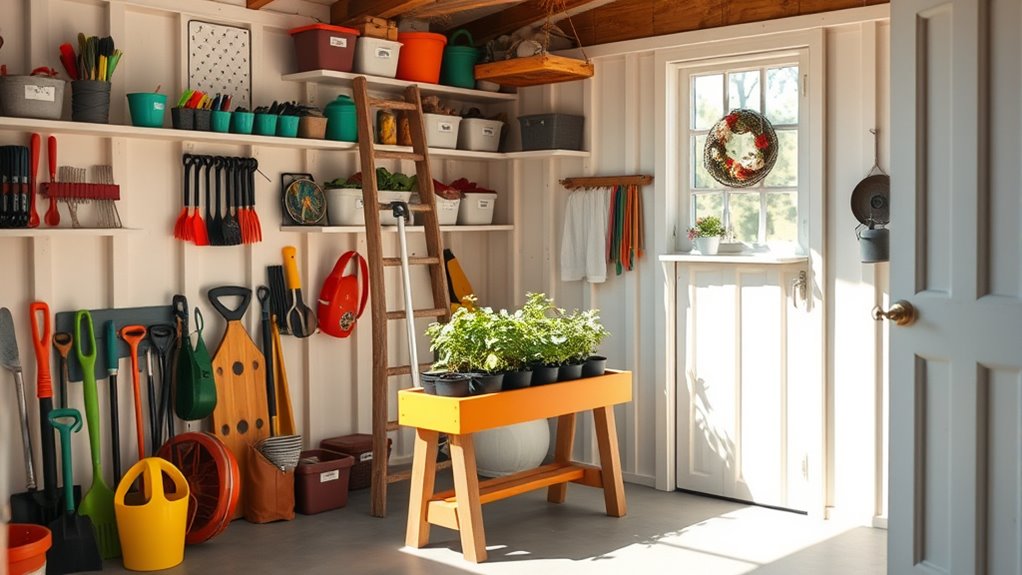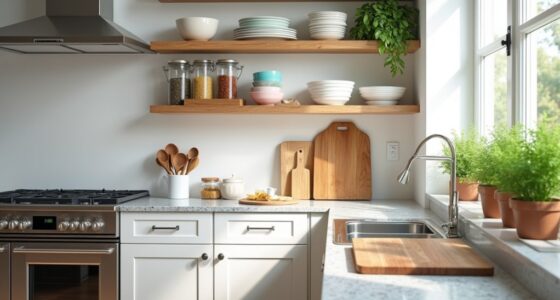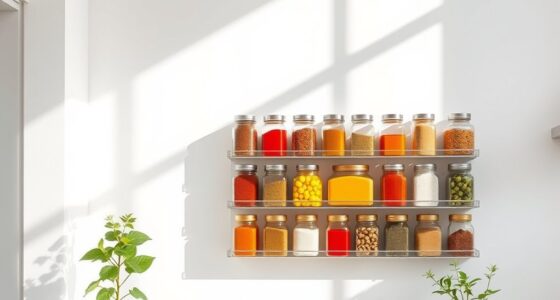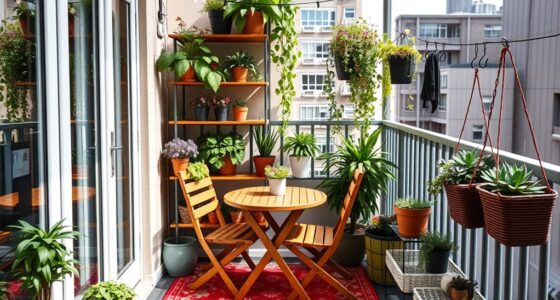To organize your shed for easy access, start by decluttering and categorizing items. Maximize vertical space with shelves, lofts, and pegboards. Use clear labels on bins and shelves for quick identification. Implement effective tool organization strategies like tool racks and cabinets. Regularly maintain cleanliness to prevent clutter buildup and ensure everything stays in order. With these steps, you'll make accessing your tools and supplies a breeze. Explore additional tips to further enhance your shed's organization and efficiency.
Key Takeaways
- Empty the shed and categorize items into keep, sell, donate, or discard piles to assess what you truly need.
- Maximize vertical space by installing shelves and lofts to store rarely used items out of the way.
- Use clear and legible labels on bins and shelves for easy identification and quicker access to tools.
- Organize frequently used tools at eye level and utilize pegboards for efficient storage and retrieval.
- Schedule regular maintenance and reassess your organization system to keep your shed clutter-free and accessible.
Maximize Vertical Space

To maximize vertical space in your shed, consider installing lofts and wall-mounted shelving, as these solutions can significantly increase your storage capacity. Lofts are perfect for storing items you rarely use, like seasonal decorations or camping gear. Just make sure to use sturdy plywood and support beams for security, and ensure you have enough headroom underneath for easy access. Additionally, ceiling-mounted storage options can help you store long and flat objects, keeping them out of the way while maximizing your space. Wall-mounted shelving can accommodate various item sizes, so install shelves at different heights. Incorporating moisture-resistant materials can also help protect your stored items from damp conditions. Use heavy-duty brackets for stability and label bins for quick identification. Clear plastic bins work well for small tools, while adjustable shelves offer flexibility for changing storage needs. With these strategies, you'll make the most of every inch in your shed.
Declutter for Efficiency
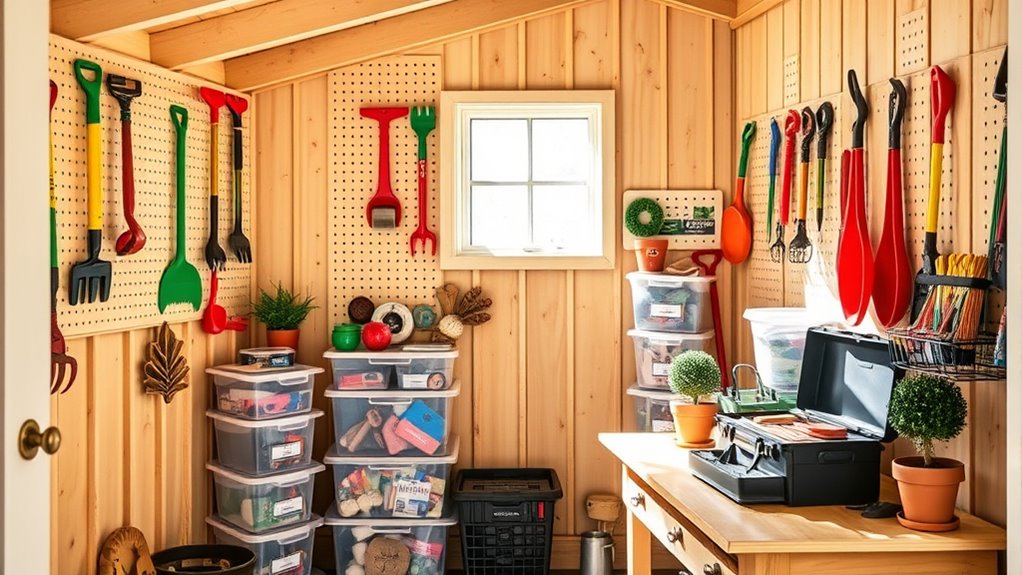
After maximizing vertical space, the next step is tackling the clutter in your shed.
Start by emptying everything out to see exactly what you have. Categorize items into groups like gardening tools, seasonal decorations, and clothing. Identify any unwanted or broken items—these need to go. Dispose of them by selling, donating, or recycling. Recognizing the need to declutter is essential for creating an organized and functional space.
If you're unsure about something, create a "maybe" pile for later review. Use clear bins for small items to maintain visibility, and consider adjustable shelving for varying sizes.
Designate zones for different categories and keep frequently used items easily accessible. By decluttering effectively, you'll create a more efficient space, making it easier to find what you need when you need it.
Organize With Labels

Organizing your shed becomes much easier when you incorporate labels, as they create a clear system for identifying items at a glance.
Use clear and legible labels on bins and shelves, ensuring they're visible from a distance. You can choose from various label types—printed, handwritten, or even removable options like chalk or washi tape. Sticker labels with Xyron Creative Station allow for easy customization and application, making it a versatile choice for your labeling needs. Additionally, utilizing vertical storage solutions can maximize space in your shed, making it even more organized.
Ensure your labels are clear and visible from a distance, using printed, handwritten, or removable options for flexibility.
Regularly update your labels to reflect any changes in contents, preventing confusion. Consider color coding for enhanced categorization and visual appeal.
Labels help you quickly locate tools and supplies, reducing search time. They also assist others in navigating your shed, making it a more accessible space.
With a solid labeling system, you'll maintain organization and streamline your shed's functionality.
Utilize Shelving Solutions
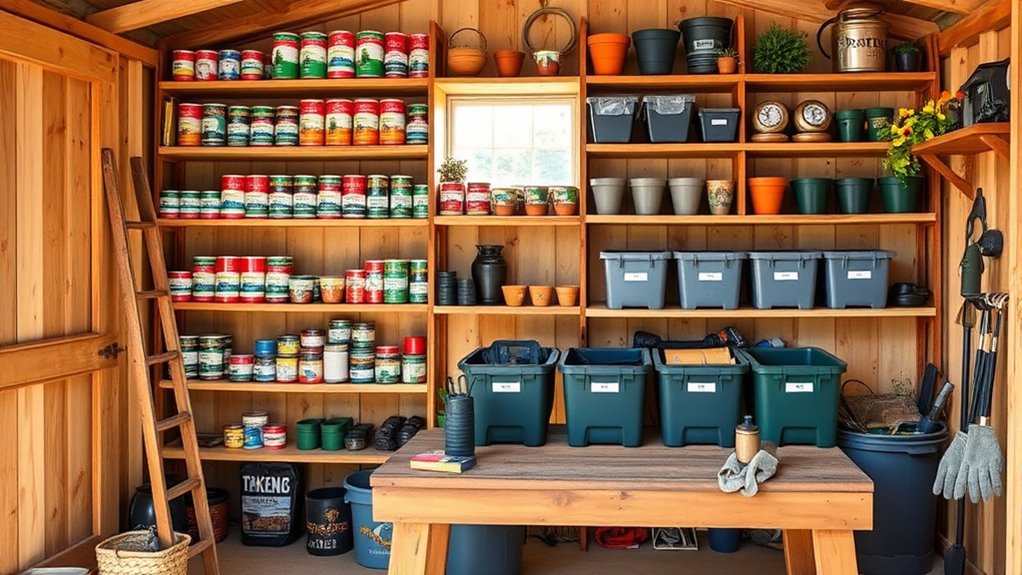
Having the right shelving solutions can significantly enhance the organization of your shed. Start by using adjustable shelves, which let you rearrange items of different sizes, maximizing vertical space. Choose durable materials like metal or wood for strength and flexibility. Additionally, regularly reorganizing your shed ensures that items are stored efficiently and unneeded items are discarded, maintaining an organized environment. To further enhance the functionality of your shed, consider adding custom storage solutions that cater specifically to your tools and supplies.
Free-standing shelves are another great option; they're portable, easy to set up, and perfect for storing bins and containers. Floating shelves optimize wall space, keeping floors clear and adding aesthetic appeal. If you're looking for a budget-friendly option, repurpose existing bookshelves to store gardening supplies and tools. Finally, consider building custom shelves tailored to your specific needs. This DIY approach allows for flexibility and durability, ensuring your shed remains organized and functional.
Implement Tool Organization Strategies
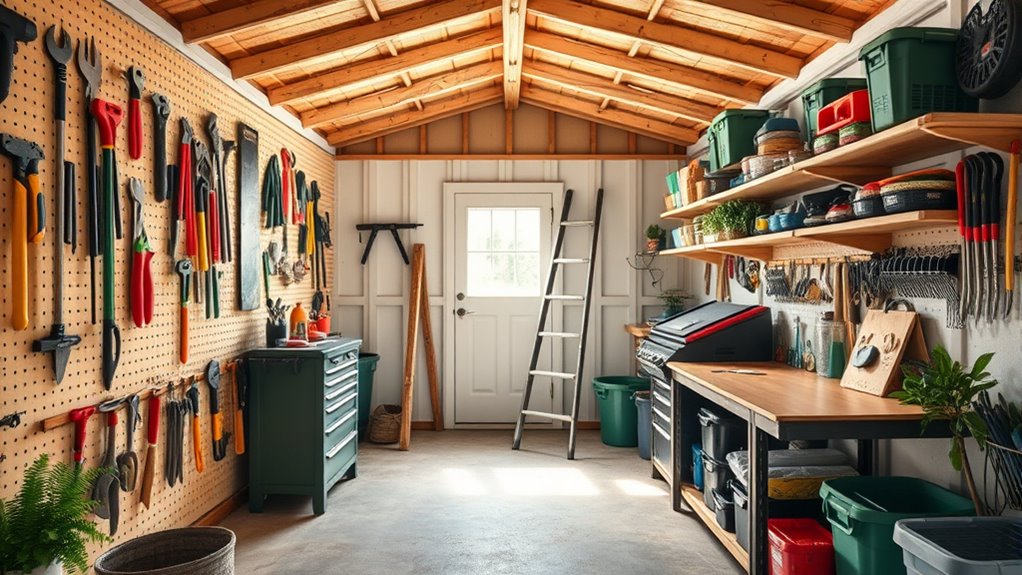
Once you've set up your shelving solutions, it's time to tackle tool organization.
Start by removing everything from your shed and categorizing items into keep, sell, donate, and discard piles. Discard broken or unused tools to free up space, then clean the shed to create a fresh start. Regular maintenance is key, as professional cleaning services can help keep your shed in top condition.
Install pegboards for hanging tools and consider using magnetic strips for metal items. Group similar tools together and label each category for easy identification. Prioritize frequently used items to ensure they are within reach, while seasonal tools can go in less accessible spots. Implement a labeling system and maintain it by regularly updating labels and scheduling cleaning sessions.
This ensures you keep your shed organized and clutter-free over time.
Create DIY Storage Solutions
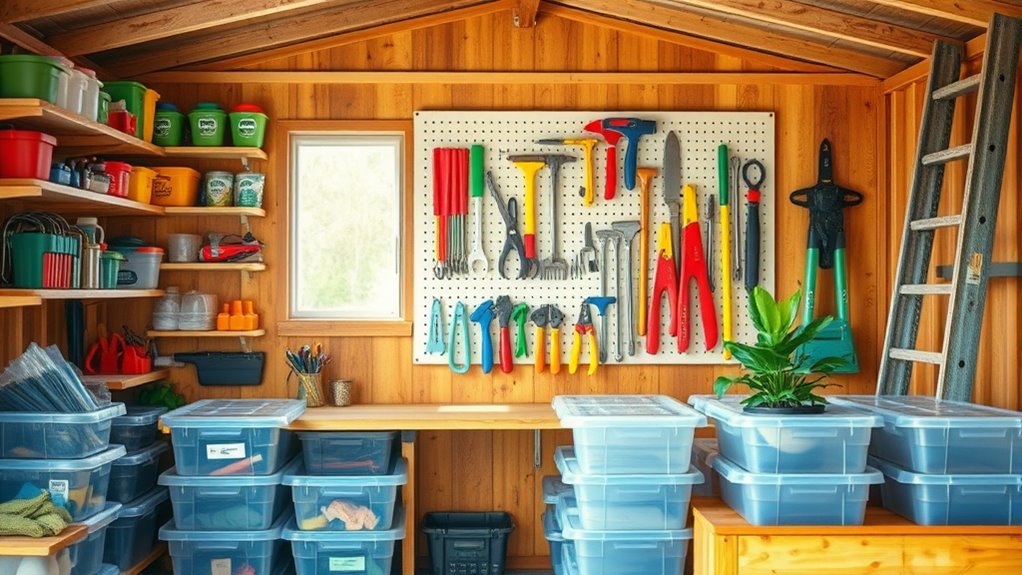
While you might think that organizing a shed requires expensive storage solutions, you can actually create effective DIY storage options with materials you already have. Start by repurposing old pallets to store long-handled tools like rakes and shovels. Empty jars work great for keeping small hardware, such as nails and screws, neatly organized. A simple scrap wood organizer can keep your materials in check. For a quick project, make a shovel rack to hang your tools. Additionally, utilize PVC pipes to create cord holders, keeping cables and hoses from tangling. Remember to store items that are not moisture sensitive in your shed to maintain their condition. With these DIY ideas, you'll maximize your shed's space without breaking the bank, all while ensuring everything is easily accessible when you need it.
Ensure Efficient Access

To ensure efficient access in your shed, start by planning an effective layout that prioritizes accessibility and organization.
Utilize vertical shelving to make the most of your wall height, keeping the floor clear for easy movement. Create designated zones for different types of items, which enhances both efficiency and accessibility. Implementing vertical shelving can help maximize space while keeping essential tools easily accessible.
Consider adjustable wall organization systems for a tailored approach. Make sure to maintain clear pathways to improve safety while navigating your shed.
Incorporate pegboards and wall racks to keep tools and equipment organized and within reach, freeing up valuable floor space.
Lastly, maintain an inventory list to track stock levels and prevent clutter, making it easier to find what you need when you need it.
Maintain Cleanliness and Order
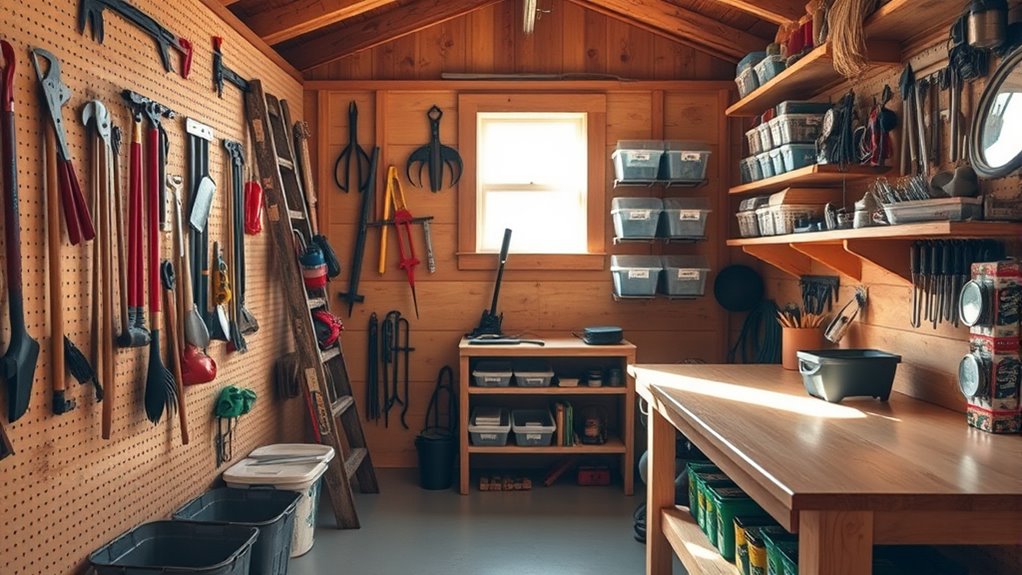
Maintaining cleanliness and order in your shed not only enhances its appearance but also improves functionality.
Start by decluttering; remove items you haven't used in over a year and categorize everything into keep, donate, or discard piles. Schedule regular maintenance to prevent clutter from piling up. Utilize vertical space by installing shelves and pegboards to keep tools accessible and off the floor. Use labeled storage bins for organization, ensuring clear identification of contents. Incorporate tool racks for larger tools to maximize wall space and enhance accessibility.
Keep your shed clean with easy-to-clean floors, regular sweeping, and pest prevention measures. Additionally, implement organizational systems like tool cabinets and shadow boards to maintain order. Regularly check and update your setup to ensure your shed remains a functional, tidy space.
Frequently Asked Questions
What Are the Best Materials for Shed Flooring?
When choosing the best materials for your shed flooring, consider your needs.
Plywood is durable but requires sealing. Concrete offers strength but can be cold.
Vinyl plank flooring is easy to maintain and stylish. Rubber tiles provide a soft surface, ideal for heavy use.
If you're looking for durability and aesthetics, epoxy coating is a great choice.
Each option has its pros and cons, so pick what fits your shed and budget best.
How Can I Prevent Pests in My Shed?
Imagine stepping into your shed, only to find unwelcome critters scurrying away.
To prevent pests, seal gaps with caulk, install weatherstripping, and block small openings with steel wool.
Keep the space clean by sweeping away debris and removing clutter. Store items in airtight containers and elevate them off the ground.
Regularly inspect for signs of infestations, and don't forget to use natural repellents like herbs to keep those pesky intruders at bay.
What Size Shed Do I Need for My Tools?
To determine what size shed you need for your tools, start by listing the items you plan to store, like garden tools, bikes, or larger equipment.
If you've got just a few small tools, a small shed might suffice. However, for larger items, consider a medium or large shed.
Don't forget to factor in future purchases—having a little extra space can save you hassle down the road!
How Often Should I Clean My Shed?
You might think your shed can go untouched for ages, but that could lead to a mess you can't ignore.
Cleaning your shed is essential—interior cleaning should happen weekly to keep dirt at bay, while exterior cleaning depends on the weather.
Seasonal tasks like power-washing in spring or autumn help maintain its appearance.
If your shed's in a debris-prone area, you'll need to up your cleaning game more often.
Don't let clutter take over!
Can I Install Electricity in My Shed?
Yes, you can install electricity in your shed, but you'll need to get the necessary permits first.
Assess your electrical needs, considering the number of outlets and lighting required.
Make sure all work complies with safety standards, and if you're unsure about any part of the process, hiring a licensed electrician is a wise choice.
Remember to check local zoning regulations to avoid any legal issues down the line.
Conclusion
By transforming your shed into an organized haven, you're not just saving space—you're unleashing the inner superhero of efficiency! You'll find tools faster than a speeding bullet, and the clutter will vanish like a magician's trick. With your shed's newfound order, you'll wonder how you ever managed chaos before. So, grab those labels and shelving solutions, and get ready to bask in the glory of easy access. Your shed will become the envy of every neighbor!
